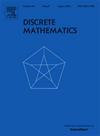A characterisation of lines in finite Lie incidence geometries of classical type
IF 0.7
3区 数学
Q2 MATHEMATICS
引用次数: 0
Abstract
We consider any classical Grassmannian geometry Γ; that is, any projective or polar Grassmann space. Suppose every line in Γ contains points. Then we classify all sets of points in Γ of cardinality , with the property, that no object of opposite type in the corresponding building, is opposite every point of the set. It turns out that such sets are either lines, or hyperbolic lines in symplectic residues, or ovoids in large symplectic subquadrangles of rank 2 residues in characteristic 2. This is a far-reaching extension of a famous and fundamental result of Bose & Burton from the 1960s. We describe a new way to classify geometric lines in finite classical geometries and how our results correspond to blocking sets.
经典型有限李关联几何中线的表征
我们考虑任何经典格拉斯曼几何Γ;也就是说,任何投影或极格斯曼空间。假设Γ中的每条线包含s+1个点。然后我们对Γ中基数为s+1的所有点的集合进行分类,其性质是,在相应的建筑物中没有相反类型的物体在集合的每个点的对面。结果表明,这样的集合要么是直线,要么是辛残中的双曲线,要么是特征2中2阶残的大辛亚四边形中的卵圆。这是对玻色一个著名的基本结果的深远延伸。60年代的伯顿。本文描述了一种在有限经典几何中对几何线进行分类的新方法,以及我们的结果如何对应于块集。
本文章由计算机程序翻译,如有差异,请以英文原文为准。
求助全文
约1分钟内获得全文
求助全文
来源期刊

Discrete Mathematics
数学-数学
CiteScore
1.50
自引率
12.50%
发文量
424
审稿时长
6 months
期刊介绍:
Discrete Mathematics provides a common forum for significant research in many areas of discrete mathematics and combinatorics. Among the fields covered by Discrete Mathematics are graph and hypergraph theory, enumeration, coding theory, block designs, the combinatorics of partially ordered sets, extremal set theory, matroid theory, algebraic combinatorics, discrete geometry, matrices, and discrete probability theory.
Items in the journal include research articles (Contributions or Notes, depending on length) and survey/expository articles (Perspectives). Efforts are made to process the submission of Notes (short articles) quickly. The Perspectives section features expository articles accessible to a broad audience that cast new light or present unifying points of view on well-known or insufficiently-known topics.
 求助内容:
求助内容: 应助结果提醒方式:
应助结果提醒方式:


